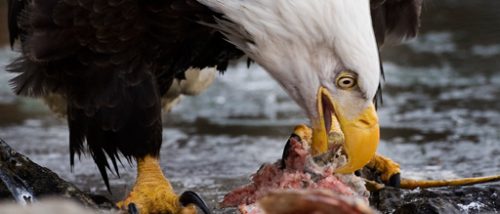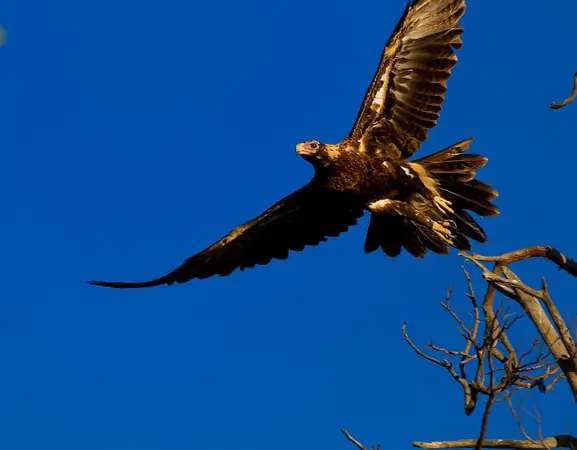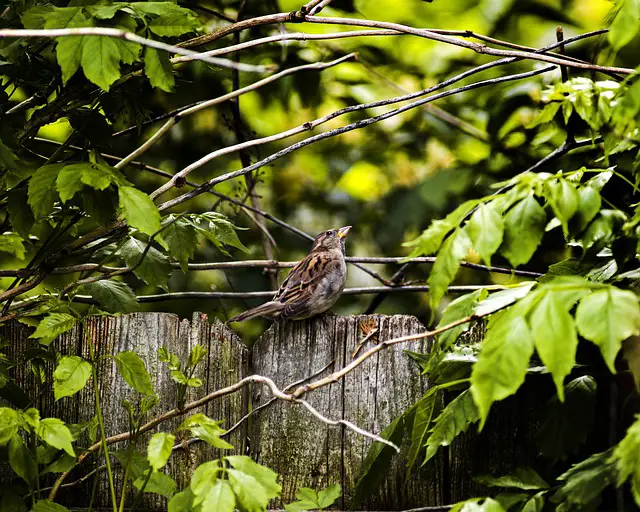The bald eagle is often seen soaring above water on broad 7.9’ wings. It is found in the North America (Alaska). Bald eagles are opportunistic feeders with an unusual ability to consume a diverse type of prey. However fish is the regular part of their diet.
What Do Bald Eagles Eat
The carrion-eater bald eagle is a powerful scavenger and predator. It is most likely to feed on fish, both live and dead. The white-headed American eagle rarely takes on small mammals, carrion, invertebrates, other birds, reptiles, as well as human refuse. However, fish forms the essential part of their eagle’s diet.
During summer, bald eagle likes to eat fish and birds (especially seabirds and waterfowl) but reptiles also make up the fair percentage of diet by number.
During winter, eagles will take small mammals along with the carrion to supplement their diet.
Learn More: Bald Eagle Diet and Eating Habits

Bald eagles have the most usual way of hunting prey. They hunt from exposed perch on the highest branch of a tree and as it makes its move towards a prey, it glides gradually to grab a fish or waterbird on or near water surface. Eagle is less likely to catch directly from the air. It is able to take the bird on the wing while knocking down and killing species as large as a goose.
Bald eagles are also known to hunt migratory fish mainly those that travel to spawning grounds. They prey on streams or shallow waters for fish. From a high perch the bald eagle overlooks water by scanning the water surface for fish. It throws its feet down just at the last moment when the bird is about to grab the fish.
The female eagles must work too hard to feed hungry young as it becomes a highly demanding task.
During the autumn which is perhaps the most favorite season of bald eagles in Alaska; they gather around in large numbers to feed on exhausted and drying fish. The salmon swim upstream and die and thus are later consumed by large American white-headed birds. The numbers can go up to 2,000 but few other species also wade through fast-flowing waters for weakened fish.
Eagles living in the southeast Alaska are more apt to feed on fish rather regularly with 66% of the diet is composed of fish all year-round. However in the Columbia River Estuary 90% of eagles’ diet is composed of fish.
In the Pacific Northwest eagles prey on coho salmon, sockeye salmon, and pink salmon. Bald eagles often feed on Pacific herring (Clupea pallasii), Pacific sand lance (Ammodytes hexapterus) and eulachon (Thaleichthys pacificus) in the shallow waters of southern Alaska.
In Florida eagles consume brown bullhead (Ameiurus nebulosus), catfish, eels, needlefish, trout, and mullet.
Bald eagles are likely to dominate other scavengers when it comes to fighting for food. These competitors include foxes, vultures, coyotes, raptors, and gulls. But they are less active than golden eagles. They are able to grab fish weighing 1 to 3 kg (2.2 to 6.6 lb) and many waterbirds as heavy as 0.2 to 2.7 kg (0.44 to 5.95 lb) .
While the young eagles feed on dead animals the adult bald eagles prey on live kill.
The heaviest prey bald eagles have ever caught while flying is a young 6.8 kg mule deer. According to an estimate they have a gripping power ten times greater than humans.
Bald eagles are known to prey mammals such as ground squirrels, muskrats, raccoons, deer fawns, beavers, hares, and rabbits. eagle’s diet also includes grebes, alcids,ducks, gulls, coots, herons, egrets, and geese.








